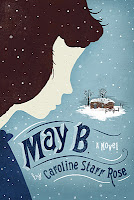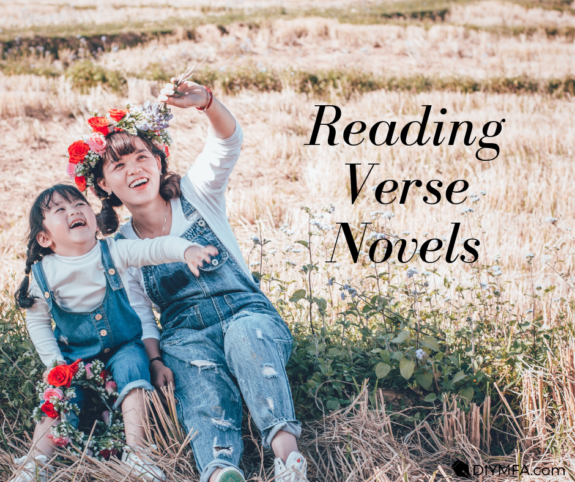Today I’d like to welcome Caroline Starr Rose back to DIY MFA. Caroline and I met through the blogsphere in 2010, when she hosted a Verse Novel Challenge on her blog. Being a fan of verse novels, I joined the challenge and have had the pleasure of following her writing and publishing journey ever since. When I decided to host a poetry and verse novel series here at DIY MFA, I knew I had to get Caroline in on it. She’s written a marvelous post that introduces verse novels, and goes through the nuts and bolts of reading and writing them. Without further ado, here’s Caroline’s take on verse novels.
Verse novels are stories told through un-rhymed poetry. It’s a format that can be intimidating to some readers, so to make the genre feel more accessible, I thought I’d try to demystify them a bit. Here are some things verse novels usually have in common:
Subject matter must be right for poetry.
Some topics lend themselves more easily to poetry than others. Some subjects refuse to be written as prose. Many times an author will use verse to mimic the rhythm of the story. Here are a few books that come to mind:
- Sharon Creech’s HEARTBEAT, about a girl who loves to run
- Karen Hesse’s OUT OF THE DUST, where the spare language reflects the stark Dust Bowl setting
- Lisa Schroeder’s FAR FROM YOU, about a girl who sings and and writes songs
Protagonists must be right for poetry.
Often (though not always) verse novels are told from a very close first-person point of view. Such writing calls for a lot of introspection on the protagonist’s part. Other times verse is used as a way for multiple voices to be heard, almost like a Greek chorus. Here are some examples:
- Thanhha Lai’s INSIDE OUT AND BACK AGAIN, about a Vietnamese girl’s efforts to understand her new American home
- Karen Hesse’s WITNESS, where the Ku Klux Klan moves into a quiet Vermont town, and citizens reflect on the change they bring
Poems should be able stand alone.
Each poem in a verse novel must capture one moment, scene, idea, mark of change in your character’s life. Poems should also be able to function separately from the rest of the story.
Poems must contribute to the whole.
When I worked through my own verse novel, MAY B., I kept a quilt in mind, treating each poem like its own square of fabric. Each patch had to be able to function separately while at the same time move the story forward. I trusted that if certain patterns and shades in my story quilt were repeated (think themes or story strands), eventually the interconnectedness would surface — a much more organic approach than is normally taken with prose.
Varied poem lengths.
Some scenes flow, some end abruptly. Some thoughts wander, some jab. Without the structure of chapters, verse novels are simultaneously abrupt and fluid — poem lengths can be jagged yet aide the plot in moving through scenes swiftly. It is often difficult to find a place to stop reading, as one poem often bleeds into the next.
Varied line lengths.
Verse novelists play with key phrases or words they want to bring to their reader’s attention by the way they arrange words on the page. Line breaks can be used to slow down reading, to draw the eye to important phrases, and to best “speak” the poem.
Emotion and structure.
The structure of a poem often communicates to readers a character’s emotional state. How might fear look structurally? A verse novelist might use little punctuation or words tightly packed together. Maybe the language of the poem will unfold in short bursts, reminiscent of a child peeking into a darkened room and quickly slamming the door.
Poetic form.
Some verse novelists use specific types of poetry (sonnets, for example), as Pat Brisson did with her book, THE BEST AND HARDEST THING. In writing about Sylvia Plath in YOUR OWN, SLYVIA, author Stephanie Hemphill chose to mirror the format of several of Plath’s poems, giving her readers a sense of the poet’s style, subject matter, intensity, and character.
The visual and the aural.
When I was a teacher, I used to tell my students that poetry should be seen and heard. There is something special that happens when a reader experiences seeing, hearing, and saying a poem all at once — the fullness of the poem is discovered this way.
Verse novels aren’t books with strange line breaks. They are stories best communicated through the language, rhythm, imagery and structure of poetry. Don’t be afraid to give books in this unique genre a try!
To show you some of the techniques mentioned above, I’ve included a sample poem from my verse novel, MAY B.
I play a game inside my head, [1]
counting plum trees that dot a creek bed, [2]
rabbits that scatter at the sound of wagon wheels,
clouds that skirt the sky.
For hours, that is all
and grass
always grass [3]
in different shades and textures [4]
like the braids in a rag rug.
Miss Sanders told us that lines never end,
and numbers go on forever.
Here, [5]
in short-grass country,
I understand infinity. [6] [7]

 Caroline Starr Rose is a former middle school English and social studies teacher. Her middle-grade novel, May B., a historical novel-in-verse, releases January 10, 2012 (Schwartz and Wade / Random House Children’s Books).
Caroline Starr Rose is a former middle school English and social studies teacher. Her middle-grade novel, May B., a historical novel-in-verse, releases January 10, 2012 (Schwartz and Wade / Random House Children’s Books).
[1] Much of the story is told through thought, not dialogue. We have a real sense of May’s internal life.
[2] Verse allows for the opportunity to play with language. Here’s a bit of rhyme.
[3] Repetition for emphasis. The line break here also slows down the reader, emphasizing the miles of grass.
[4] Poetry should be visual and figurative language fresh, even unexpected.
[5] Line break for emphasis
[6] The two stanzas mirror each other in appearance, reinforcing the visual aspect of experiencing poetry.
[7] Notice the poem is about place and uses measurements/counting as a way to make sense of things. The few trees and rabbits are a contrast to infinity. The poem fits into the overall story — May leaving for a new place — but can also stand alone as a poem about the short-grass Kansas prairie.







